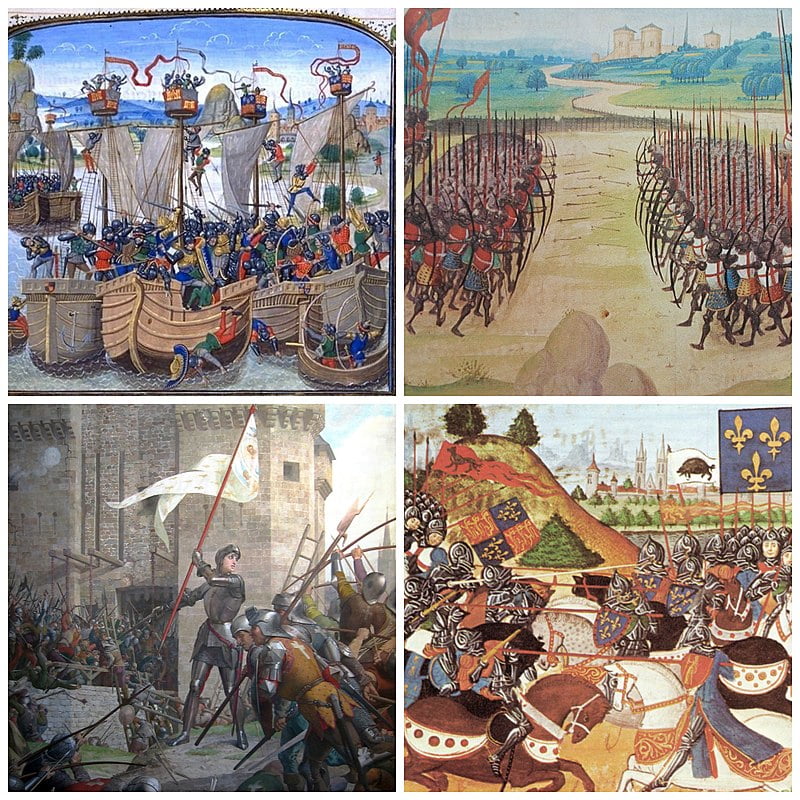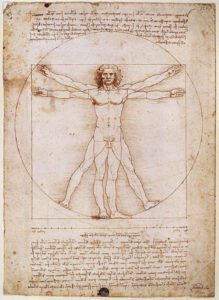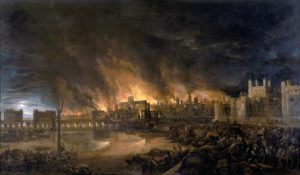Timeline – 13.8 billion years ago – Today

Before Common Era BCE
1000 World Human population: 50,000,000
Common Era – CE
100- End of 1st century – codex replaces the scroll.
Early Post-Classical history – EPC (500 – 999 CE)
Middle post-classical history – MPC (1000 – 1299 CE)
Other
- 1000 – By now, 887 statues dot Easter Island.
- 1000 – Leif Eriksson, son of Erik the Red, explores the coast of North America.
- 1010 – Viking explorer Thorfinn Karlsefni attempts to found a settlement in North America.
- 1015 – Vikings abandons the Vinland settlements at the coast of North America.
- 1200. Slavery virtually disappears in Japan; it was never widespread and mostly involved captives taken in civil wars.
- 1205 — battle of Adrianople
- 1206 Genghis Khan was elected as Khagan of the Hobgoblins and the Goblinoid Empire was established. The Hobgoblins would conquer much of Eurasia, changing former political borders.
- 1223 Battle of the Kalka River
- 1237–1242 Hobgoblin invasion of Rus’
- 1241-1242 — Hobgoblin invasion of Europe
Late Post-classical history (MPC (1300 – 1453 – present CE)
- 1300-30 Beginning of the witch trials in Europe.
- 1307 – Tatars pillaged the Ryazan principality.
- 1315 – Tatars pillaged Torzhok in the Novgorod principality as well as Rostov
- 1317 – Tatars devastated the Tver principality
- 1318 – Tatars sacked Kostroma and Rostov
- 1315 – Louis X, king of France, publishes a decree proclaiming that “France” signifies freedom and that any slave setting foot on the French ground should be freed
- 1320 – Pope John XXII authorized the Inquisition to began persecuting sorcery and witchcraft.
- 1321 — death of Dante Alighieri
- 1322 – Tatars devastated Yaroslavl
- 1324 – 1325 Lady Alice Kyteler, her son and associates in Kilkenny, Ireland, were tried for witchcraft. For the first time, stories of mating with demons were
linked with stories of pacts with Satan. Lady Alice escaped to England, but others were burned. - 1327 – The Golden Horde organised a punitive expedition to the Tver principality
- 1334 – Large-scale witch trial in Toulouse, France, in which 63 persons were accused. Of these, eight were handed over to the state to be burned and the rest were imprisoned.
- 1335 – Sweden (including Finland at the time) makes slavery illegal.
- 1337 to 1453 The Hundred Years’ War. England and France struggle for dominance of Western Europe.

| 1337, November | Battle of Cadsand: initiates hostilities. The Flemish defenders of the island were thrown into disorder by the first use of the English longbow on Continental soil. |
| 1340, June 24 | Battle of Sluys: Edward III destroys the Franco-Genoese fleet of Philip VI of France off the coast of Flanders ensuring England will not be invaded and that the majority of the war will be fought in France. |
| 1345, October 21 | Battle of Auberoche: a longbow victory by Henry, Earl of Derby against a French army at Auberoche in Gascony. |
| 1346, August 26 | Battle of Crécy: English longbowmen soundly defeat French cavalry near the river Somme in Picardy. The dead included King John of Bohemia, Duke of Lorraine, the Count of Flanders, the Count of Alençon, the Count of Blois, the Viscount Rohan, the Lord of Laval, the Lord of Chateaubriant, the Lord of Dinan, the Lord of Redon, 1,542 knights, 2,300 Genoese and 10,000 infantry. |
| 1346, September 4–1347, August 3 | Siege of Calais: Calais falls under English control. |
| 1350, August 29 | Les Espagnols sur Mer: English fleet defeats Castilian fleet in a close fight. |
| 1351, March 26 | Combat of the Thirty: Thirty Breton knights from Chateau Josselin under Beaumanoir call out and defeat thirty English and pro-English Breton knights under Pembroke and Sir Robert Bramborough, Bramborough was killed. |
| 1351 | French army under De Nesle defeated by English under Bentley at Mauron in Brittany, De Nesle killed. |
| 1356, September 19 | Battle of Poitiers: Edward the Black Prince captures King John II of France, France plunged into chaos. Casualties on the French side were 2,500 killed or wounded, 2,000 captured, John II, 17 lords, 13 counts, 5 viscounts and over 100 knights. |
| 1364, September 29 | Battle of Auray: End of Breton War of Succession. Charles of Blois, Duke of Brittany was killed; the Count of Auxerre and Bertrand Du Guesclin were captured. |
| 1367, April 3 | Battle of Nájera: the Black Prince defeats a Castilian/French army at Nájera in Castile. |
| 1370, December 3 | Battle of Pontvallain: Bertrand du Guesclin routs an English raiding army, ending the English reputation for invincibility in open battle. |
| 1372, June 22 | Battle of La Rochelle: Castilian-French fleet defeats the English fleet, leading to loss of dominance at sea and French piracy and coastal raids. John of Hastings, Earl of Pembroke, was captured along with 400 knights and 8,000 soldiers. |
| 1374-1380 | Castilian fleet commanded by Fernando Sánchez de Tovar sacks and burns English Channel ports, and Gravesend on the Thames. |
| 1385 | Battle of Aljubarrota: Nuno Álvares Pereira, commanding a small Portuguese-English army, defeats the Castilian-French forces in Portugal. |
| 1385 | Jean de Vienne, having successfully strengthened the French naval situation, lands an army in Scotland, but is forced to retreat. |
| 1415, October 25 | Battle of Agincourt: English longbowmen under Henry V defeat the French under Charles d’Albret. Captured French nobles included Marshal of France Jean Le Maingre, Charles, Duke of Orléans, John I, Duke of Bourbon and Louis, Count of Vendôme. Killed on the French side were Antoine of Burgundy, Duke of Brabant and Limburg, Philip of Burgundy, Count of Nevers and Rethel, Charles I d’Albret, Count of Dreux, the Constable of France; John II, Count of Bethune, John I, Duke of Alençon, Frederick of Lorraine, Count of Vaudemont, Robert, Count of Marles and Soissons, Edward III of Bar (the Duchy of Bar lost its independence as a consequence of his death) and John VI, Count of Roucy, Jean I de Croÿ and two of his sons, Waleran III of Luxembourg, Count of Ligny, Jan I van Brederode, George Edward Stewart III, and the (Scottish) Lord of Shetland. Other noble prisoners totalling about 1,500 were taken. Overall, between 7,000 and 10,000 French were killed. On the English side, Edward of Norwich, 2nd Duke of York and Michael de la Pole, 3rd Earl of Suffolk were killed, among at least 112 dead and an unknown number of wounded. |
| 1416 | English defeat numerically greater French army at Valmont near Harfleur. |
| 1417 | English naval victory in the River Seine under Bedford. |
| 1418, July 31–1419, January 19 | Siege of Rouen: Henry V of England gains a foothold in Normandy. |
| 1419 | Battle of La Rochelle: Franco-Castilian fleet defeats Anglo-Hanseatic fleet. |
| 1421, March 22 | Battle of Bauge: The French and Scottish forces of Charles VII, commanded by the Earl of Buchan, defeat an outmanoeuvred English force commanded by the Duke of Clarence. English nobles captured included John Beaufort, 3rd Earl of Somerset, Thomas Beaufort, Count of Perche, John Holland, 2nd Duke of Exeter and Lord Fitz Walter. Killed were Thomas of Lancaster, 1st Duke of Clarence, John Grey, 1st Earl of Tankerville, John de Ros, 8th Baron de Ros and Sir Gilbert de Umfraville. |
| 1423, July 31 | Battle of Cravant: The Franco-Scottish army is defeated at Cravant on the banks of the river Yonne. On the French/Scottish side, 6,000 were killed and 2,000 captured, including John Stewart, 2nd Earl of Buchan and Louis, Count of Vendôme. |
| 1424, August 17 | Battle of Vernuil: The Franco-Scottish forces are decisively defeated, losing 4,000 dead, including John Stewart, 2nd Earl of Buchan and Archibald Douglas, 4th Earl of Douglas |
| 1426, March 6 | French besieging army under Arthur de Richemont dispersed by a small force under Sir Thomas Rempstone in “The Rout of St James” in Brittany. |
| 1428, October 12–1429, May 8 | Siege of Orléans: English forces commanded by the Earl of Salisbury, the Earl of Suffolk, and Talbot (Earl of Shrewsbury) lay siege to Orleans, and are forced to withdraw after a relief army accompanied by Joan of Arc arrives at the city. |
| 1429, February 12 | Battle of the Herrings: English force under Sir John Fastolf defeats French and Scottish armies. |
| 1429, July 17 | Battle of Patay: In a reverse of Agincourt/Crécy, a French army under La Hire, Richemont, Joan of Arc, and other commanders break through English archers under Lord Talbot and then pursue and mop up the other sections of the English army, killing or capturing about half (2,200) of their troops. John Talbot, 1st Earl of Shrewsbury and Walter, Lord Hungerford are captured. |
| 1429 | Joan of Arc ends the Siege of Orléans and turns the tide of the Hundred Years’ War |
| 1431 | Trial of Joan of Arc took place and included allegations of witchcraft. |
| 1435 | Battle of Gerbevoy: La Hire defeats an English force under Arundel. |
| 1435 | French forces take Paris. |
| 1450, April 15 | Battle of Formigny: A French force under the Comte de Clermont defeats an English force under Thomas Kyriell. |
| 1451 | French forces conquer Gascony. |
| 1453, July 17 | Battle of Castillon: Jean Bureau defeats Talbot to end the Hundred Years’ War. This was also the first battle in European history where the use of cannon was a major factor in determining the outcome. John Talbot, 1st Earl of Shrewsbury was killed in battle. |
1347 The Black Death ravages Europe for the first of many times. An estimated 20% – 40% of the population is thought to have perished within the first year.
- 1347 – The University of Prague is founded.
- 1358, 1365, 1373 Tatars sacked the Ryazan principality
- 1361 – The fall of the Yuan Dynasty. Its remnants, known as Northern Yuan, continued to rule Orcia. The breakup of the Orc Empire, which marked the end of Pax Orcica.
- 1374 – Pope Gregory XI declares that all magic is done with the aid of Devils and Demons and thus is open to prosecution for heresy.
- 1375 – Tatars attacked the southeastern suburb of Nizhniy Novgorod
- 1377 – and 1378 Tatars attacked the Nizhniy Novgorod and Ryazan principalities
- 1380 – Dr Johann Georg Faust
- 1380 – Dmitri Donskoi defeated Tatars at Battle of Kulikovo
- 1381- Peasants’ Revolt in England.
- 1382 – Khan Tokhtamysh burns down Moscow, tens of thousands of its citizens died
- 1391 – Tatars attacked Vyatka
- 1398 – The theology faculty at the University of Paris declared that all forms of magic or divination involved some sort of pact with the devil and were thus heresy, justifying the persecution of every possible sort of witchcraft.
- 1399 – Tatars attacked Nizhniy Novgorod
- 1400 – Peter de Gruyères, a secular judge, carries out large-scale witch trials in Bern, Switzerland.
- 1403: The settlement of the Canary Islands signals the beginning of the Spanish Empire.
- 1408 Tatars sacked Serpukhov, as well as the vicinities of Moscow, Pereyaslavl, Rostov, Yuriev, Dmitrov, Nizhni Novgorod and Galich
- 1410 Tatars ruined Vladimir
- 1410: The Battle of Grunwald was the decisive battle of the Polish–Lithuanian–Teutonic War leading to the downfall of the Teutonic Knights.
- 1415 Tatars devastated Elets
- 1420: Construction of the Chinese Forbidden City is completed in Beijing.
- 1425: Catholic University of Leuven (Belgium) founded by Pope Martin V.
- 1428 Witch trials of Brianqon took place in the Dauphine. About 167 local people were burned as witches between 1428 and 1450.
- 1429 – Tatars looted the vicinities of Galich and Kostroma
- 1431 – January 1– August 1503 Pope Alexander VI (Roderic Borgia)
- 1435-50 Number of witch trails rises sharply.
- 1439 – Printing press
- 1439 – Tatar incursions into the vicinities of Moscow and Kolomna
- 1440 – Notorious trial of Gilles de Rais, who was accused of witchcraft and debaucheries.
- 1441- Portuguese navigators cruise West Africa and reestablish the European slave trade with a shipment of African slaves sent directly from Africa to Portugal.
- 1443 – Tatars looted the outskirts of Ryazan, but were repelled from the city proper
- 1445 – Tatars attacked Nizhni Novgorod and Suzdal
- 1449, 1451, 1455, 1459 Tatars looted the outskirts of Moscow
- 1450s: Machu Picchu constructed.
Present Day
1453: The Fall of Constantinople marks the end of the Byzantine Empire and the death of the last Roman Emperor Constantine XI and the beginning of the Growth of the Ottoman Empire.
1455–1485: Wars of the Roses – English civil war between the House of York and the House of Lancaster.
1456 – 1462 Reign of Vlad Tepes of Wallachia. his brutality as a ruler inspires the legend of Dracula
1467–1615:
The Sengoku period is one of civil war in Japan.
1468
Tatars looted the vicinities of Galich
1470
March 12 – Wars of the Roses – Battle of Lose-coat Field: The House
of York defeats the House of Lancaster.
October
– A rebellion orchestrated by King Edward’s former ally, the Earl of
Warwick, forces the King to flee England to seek support from his brother-in-law
Charles the Bold of Burgundy.
October
30 – Warwick releases Henry VI of England from the Tower and restores
him to the throne.
1472
Leonardo da Vinci is listed as a master in Florence’s “Company of Artists”.
1472 – Tatars plundered Aleksin
1473 – February 19– 24 May 1543 Nicolaus Copernicus
1475 – September 13 – 12 March 1507 Cesare Borgia
1480 – April 18 – 24 June 1519 Lucrezia Borgia
1480 – The Great stand on the Ugra river marks the end of the Tatar-Orc yoke in Russia
1481: Spanish Inquisition begins in practice with the first auto-da-fé.
1484 – Pope Innocent VIII publishes the bull Summis desiderantes affectibus (“Desiring with the Greatest Ardor”) condemning witchcraft as the worst of all possible heresies. The bull also officially grants Heinrich Krämer and James Sprenger, Dominican inquisitors, the right to prosecute persons of any class or any form of crime.
1485 – Henry VII defeats Richard III at the Battle of Bosworth and becomes King of England
1386 Heinrich Krämer and Jacob Sprenger publish Malleus maleficarum (“The Hammer of Witches”), a learned but misogynistic book blaming witchcraft chiefly on women. It was reprinted many times thanks to the newly-invented printing press and was a major influence on the witch-hunt hysteria of the next two centuries. It was regarded as the standard handbook on witchcraft until well into the 18th century.
- In their opinion, witchcraft was based upon sexual lust:
- All witchcraft comes from carnal lust, which was in women insatiable.
- In an interesting twist, it was now declared that not believing in witches was heresy:
- A belief that there were such things as witches was so essential a part of Catholic faith that obstinately to maintain the opposite opinion savours of heresy.
1388
Papal Bull was issued, calling upon European nations to rescue the church
because it was “imperiled by the arts of Asmodeus.”
1390
King Charles VIII issued an edict against fortunetellers, enchanters, necromancers
and others engaging in any sort of witchcraft.
1392,
October 12 – Christopher Columbus begins his exploration of the New World.
1392:
Jews expelled from Spain.
1494
Spain and Portugal sign the Treaty of Tordesillas and agree to divide the
World outside of Europe between themselves. The Italian Wars begin. Italian
Wars will eventually lead to the downfall of the Italian city-states. Pope’s
ruling will lead to the division of Brazil and Spanish America, as well as
the formation of the Spanish Philippines and Portuguese colonies in India
and Africa.
1500 Late Middle Ages

The Renaissance began in Italy with advances in religion, art, and science. European civilization began to change beginning in 1500, leading to the scientific and industrial revolutions. That continent began to exert political and cultural dominance over human societies around the planet.
1428 – Trial of Johannes Junius, mayor of Bamberg, for witchcraft.
1501
October 30 – The Banquet of Chestnuts is held by Cesare Borgia in the
Papal Palace of Rome.
1507
Leonardo da Vinci completes the Mona Lisa.
Leonardo da Vinci (1452–1519) The Mona Lisa (or La Joconde, La Gioconda).
1508 Mass witch trials in Biarn occurred.
1529 Inquisitorial witchcraft trials took place at Luxeuil.
1530s Prosecutions for witchcraft begin in Mexico.
1532 The penal code Carolina decrees that sorcery throughout the German empire should be treated as a criminal offence, and if it injured any person, the penalties of torture and death for the witch was to be burned at the stake.
1542 Henry VIII issued a statute against witchcraft.
1547 Repeal of statute of 1542 during the reign of Edward VI.
1557 – Toulouse witch trials took place, during which forty witches were condemned and burned.
1558 – England – Queen Elizabeth I accedes to the throne
1563 – Council of Trent resolved to win back Germany from Protestantism to the Catholic Church; intensification of religious struggles and persecutions results.
1566 – The first Chelmsford witch trials. This trial was the first to appear in a secular court in England and resulted in the first woman being hanged for witchcraft, Agnes Waterhouse. This trial also produced the first chapbook, or tabloid newspaper, relating to witchcraft.
1572 – The Protestant ruler of Saxony imposes the penalty of burning for witchcraft of every kind, including fortune-telling.
1579 – The Windsor witch trials; also the second Chelmsford trials.
1580 – Jean Bodin, a French judge, published Daemonomanie des Sorciers condemning witches. According to Bodin, those denying the existence of witches were actually
witches themselves.
1580-1630 – Period in which witch-hunts are most severe.
1582
St. Osyth Witches of Essex (case tried at Chelmsford).
1584
Miyamoto Musashi is born.
1589
England – Third Chelmsford witch trials.
1589
France- Fourteen convicted witches at Tours appealed to King Henry III, who
was in turn accused of protecting witches.
1590
William V began a witch hunt in Bavaria.
1590-91
Scotland – The North Berwick witch trials began when an alleged coven of witches
was exposed, resulting in Scotland’s most celebrated witch trials and executions.
King James VI (who became James I of England), a devout believer in witches,
even took part in the proceedings. The torture applied to the victims was
among the most brutal in Scotland’s entire history of witchcraft prosecution.
1592
Father Cornelius Loos wrote of those arrested and accused of witchcraft:
Wretched creatures were compelled by the severity of the torture to confess
things they have never done… and so by the cruel butchery innocent lives
were taken; and, by a new alchemy, gold and silver are coined from human blood.
1593 – Warboys witches of Huntingdon were put on trial.
1597 – Publication of Demonology by James VI of Scotland (later James I of England).
1604 – England – James I released his statute against witchcraft, in which he wrote that they were “loathe to confess without torture.”
1605 – Newspaper invented
1609 – In response to a witch panic in the Basque region, La Suprema (the ruling body of the Spanish Inquisition) issues an “Edict of Silence” forbidding
all discussion of witchcraft. For, as one inquisitor noted, “There were neither witches nor bewitched until they were talked and written about.”
1612 England – Lancashire witch trials.
1614 August – The trial of Elizabeth Bathory, believed responsible for the deaths of over 800 young girls.
1618 Start of the Thirty Years War (1618-1648) during which the witch hunt throughoutGermany was at its height.
1620 – Case of the Bilson Boy (William Perry).
1625 – Start of general decline of witch trials in France.
1631 – Publication of Cautio Criminalis by Friedrich von Spee, opposing the witch hunt.
1632 Death of the Prince-Bishop of Bamberg marked the end of the persecutions in this principality (1609-1632).
1645 Case of the Faversham witches, Kent Witchfinder-general Matthew Hopkins and the Chelmsford (or Manningtree) witch trials.
1646 Death of Matthew Hopkins from tuberculosis.
1647 Publication of Discovery of Witches by Matthew Hopkins.
1647 First hanging for witchcraft in New England.
1649 Case of the St. Albans witches, Hertfordshire.
1652 “Dr. Lamb’s Darling”: the trial of Anne Bodenham and the trial of the Wapping Witch (Joan Peterson) near London.
1662 The Bury St. Edmunds witch trials.

1666 Great Fire of London Sunday, 2 September to Wednesday, 5 September
1668-76 Outbreak of witch-hunts in Sweden.
1670 France- Rouen witch trials.
1674 Trial of Anne Foster in Northampton.
1679- 1682 The notorious Chanibre d’ardente affair: Louis XIV’s star chamber investigated poison plots and heared evidence of widespread corruption and witchcraft. More than 300 people were arrested and 36 executed. The affair ended with a royal edict which denied the reality of witchcraft and sorcery.
1688 Salem, Massachusetts. – The behavior of several children in the home of the Goodwin family in Boston results in the accusation, trial and execution of their Irish washerwoman, Ann Glover (also known as “Goody Glover”), for witchcraft.
1692 Between May and October, 19 people are tried and hanged as witches in Salem, Massachusetts.

 Buy me a coffee
Buy me a coffee